With China Walking Tour ...
[video v=Sl4DwmPekJs] Plus more videos ...
Live more ...
With China Walking Tour ...
[video v=Sl4DwmPekJs] Plus more videos ...
With Pandaland Villager ...
[video v=0i0KCiWY5v8]ShanTang River and ShanTang Street, located in SuZhou, JiangSu Province, are renowned for their picturesque beauty and historical significance. Often referred to as the "Venice of the East," ShanTang Street is a perfect blend of traditional Chinese architecture, serene waterways, and vibrant local culture, making it a must-visit destination.
ShanTang River, also known as the "Seven-Li Shantang," was originally constructed in 825 AD during the Tang Dynasty. The construction was overseen by Bai Juyi, a renowned poet and the then governor of SuZhou. The canal was built to connect SuZhou city with HuQiu (Tiger Hill), facilitating trade and transportation while providing a scenic route for travelers.
The project was an ambitious undertaking aimed at promoting economic development and improving water management in the region. The construction of the canal also helped to control flooding and provided a reliable source of water for irrigation, which was crucial for local agriculture.
Over the centuries, ShanTang River became a vital artery for the transportation of goods and people. It also served as a cultural hub, with the development of markets, temples, and residential areas along its banks. The river and the adjacent ShanTang Street became synonymous with prosperity and cultural richness, attracting scholars, merchants, and artists who contributed to the flourishing of SuZhou.
By Air: The nearest airport is SuZhou Sunan Shuofang International Airport (WUX), located about 40 kilometers from the city center. From the airport, you can take a taxi or a shuttle bus to reach ShanTang Street.
By Train: SuZhou Railway Station is well-connected with major cities like Shanghai, HangZhou, and Nanjing. From the station, you can take a local bus or taxi to reach ShanTang Street.
By Bus: SuZhou is well-served by long-distance buses from nearby cities. The main bus station in SuZhou is SuZhou North Bus Station, from where you can take a local bus or taxi to ShanTang Street.
This ancient street, with a history of over 1,100 years, stretches for about 3.5 kilometers along the ShanTang River. It is lined with well-preserved traditional buildings, charming shops, tea houses, and restaurants, offering a delightful walking experience.
The ShanTang River is a scenic waterway that flows through the heart of the town. Boat rides along the river provide a tranquil and picturesque journey, showcasing the town's beautiful bridges, ancient buildings, and lush gardens.
Located nearby, Pingjiang Road is another historic street that complements your visit to ShanTang Street. Known for its classical SuZhou gardens, traditional houses, and cultural sites, it offers a deeper understanding of SuZhou's rich heritage.
Baosheng Temple, located along ShanTang Street, is a historic Buddhist temple with beautiful architecture and serene gardens. It provides a peaceful retreat and a glimpse into the town's religious heritage.
Just a short distance from ShanTang Street, Tiger Hill is a popular tourist attraction known for its natural beauty, historical sites, and the iconic Yunyan Pagoda, often referred to as the "Leaning Tower of China."
SuZhou's cuisine is known for its delicate flavors and emphasis on fresh, seasonal ingredients. Here are some must-try dishes:
ShanTang River and ShanTang Street, with their rich history, traditional architecture, and picturesque scenery, offer a unique and memorable travel experience. Whether you're exploring ancient streets, savoring local cuisine, or taking a serene boat ride along the river, ShanTang provides an unforgettable glimpse into SuZhou's past. Plan your visit carefully to make the most of your trip to this charming destination in JiangSu Province.
With Wei's Travel ...
[video v=VoO2GV6QC-U]From ShangHai:
QingXi Ancient Water Town offers a tranquil escape from the urban hustle of ShangHai, allowing visitors to immerse themselves in China's rich cultural heritage and natural beauty. With its picturesque canals, historic architecture, and vibrant local culture, QingXi is a destination that promises a memorable and enriching experience.
With Graeme Langford ...
[video v=JZGv78iN6Bk] Plus more videos ...
With KiraVideo ...
[video v=Ui9LG9T5jJU]Discover the rich history and cultural heritage of Shaoxing, China.
Shaoxing is a city located in the Zhejiang province of China, known for its rich cultural heritage, ancient architecture, and scenic waterways. It is renowned for its historical significance and contributions to Chinese literature, arts, and politics.
Shaoxing is situated in eastern China, within the Zhejiang province. It is approximately 200 kilometers southwest of Shanghai and 60 kilometers southeast of Hangzhou.
Shaoxing boasts a history that spans over 2,500 years. It has been an important cultural and economic center since ancient times. The city is famous for being the hometown of notable historical figures such as the ancient calligrapher Wang Xizhi and the modern writer Lu Xun. Its rich cultural heritage is evident in its well-preserved ancient architecture, traditional water towns, and numerous historical sites.
With Walk East ...
[video v=Y8lRVFwl6QQ]With Reporterfy Media ...
[video v=wUPCAduqyIw]With Seiu Travel ...
Plus more videos ...
With Go Around China ...
[video v=i4C0rIowXOw]One of China's most complete ancient cities, it was formerly named XiangFan.
With Walk East ...
[video v=IHNQgpdAJvk]With Wei's Travel ...
[video v=988mOTXPy8Y]Ancient QianMen, BeiJing, hutong and park walk
Just south of TianAnMen and the Forbidden City. 北京老城闹市区的世外桃源-好似江南水乡-从鲜鱼口美食街到长巷头条风景区的胡同漫步之旅 ...
Beautiful WuYuan, JiangXi province
WuYuan, known as the "most beautiful countryside in China", with at least 50 old villages, is located in the northeast of JiangXi province, and near Mount HuangShan and JingDeZhen. With Walk East ... Max (Walk East) : Wuyuan is home to a few of the well-preserved ancient architecture in China. Each of those ancient structures has a unique appearance as well as structure. They emerge from among the emerald green mountains and trees, clear rivers along with the crisscrossing paths between the fields. Those structures were built in 740 during the Tang Dynasty; its remoteness and inconvenient transportation protecting its villages' beauty from a large amount of tourists. Local people there can enjoy the pure, clean brooks, seemingly delicate wooden buildings, unique bridges as well as the tranquil lifestyle, etc... This village has turned into a ecological, cultural as well as tourist demonstration center of China. The ancient Architectural complexes,caves, blue water, trees as well as rural sceneries; all these form a typical Chinese countryside scene Wuyuan has become a well known town in the world features in famous Huizhou local culture as well as charming idyllic scenery. Beijing Opera, Hui Opera, the Luo Dance known as the "Dance Live Fossil" as well as the charming tea performance, all these make Wuyuan fascinating tourism destination. 【Likeng Village】 Likeng Village is a cluster of houses constructed along a brook. It is said to be the most scenically beautiful village in the town. The brook is two to three meters wide spanned at different points by makeshift bridges. A rolling stream through the village lived by 260 peasant households along with ancient buildings with its pink walls, black tiles as well as beautiful girls who are washing laundry reflecting from the stream look like a natural scenery. 【Visit Local Ancient Village in Hui-style】 Wuyuan is the birthplace of the Huizhou culture. Villages around are must go, and you will be attracted by the quiet and simple countryside life there. noticeable Huizhou-style architecture can be found in these old villages, such as, arches, stone tablets, stone bridges, ancient stages, etc. Wuyuan is a county in northeastern Jiangxi province. It is renowned for its beautiful countryside and well-preserved ancient Huizhou villages and architecture. Many of the buildings and villages date from the Tang dynasty and have been protected by the county’s remoteness and relatively inconvenient transportation. Highlights and Travel Tips The area is famous for the fields of yellow rapeseed flowers that surround the villages in March and April, which are among the most beautiful in China and will delight photographers. One of the best places to see the flowers is hills surrounding the village of Jiangling. Popular villages and sights around the county include Likeng Village, Mount Dazhang (a beautiful area filled with soaring mountains and crashing waterfalls that is as yet undiscovered by tourism), Rainbow Bridge (a covered bridge), and Jiangling Village.
Restoring ancient pottery for the Palace Museum
The awesomely beautiful ancient town of LiJiang 丽江, YunNan province, in Ultra HD / 4K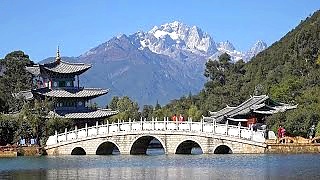
Don't miss this great film ! LiJiang is a UNESCO World Heritage Site; "LiJiang is an exceptional ancient town set in a dramatic landscape which represents the harmonious fusion of different cultural traditions to produce an urban landscape of outstanding quality."
The ancient city of PingYao 平遥, ShanXi province, in Ultra HD / 4K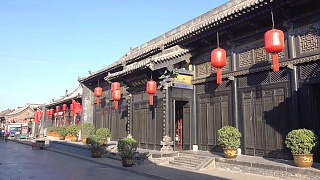
PingYao lies in ShanXi province, central China, about 700 kilometers (400 miles) southwest of BeiJing and 80 kilometers (50 miles) from the provincial capital TaiYuan.. PingYao is a UNESCO World Heritage Site for being "an exceptionally well-preserved example of a traditional Han Chinese city". PingYao is an exceptionally well-preserved example of a traditional Han Chinese city, founded in the 14th century. This ancient city is renowned for its well-preserved city walls and outlying temples. The city walls were constructed around 1370 and have six barbican gates. The walls are 12 meters high, with a perimeter of 6 kilometers. A 4 meter wide, 4 meter deep moat lies just beyond. There are also 72 watchtowers.
The beautiful ancient water town of WuZhen 乌镇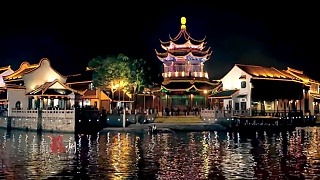
WuZhen, 乌镇, lies not far from ShangHai, where this film starts, and also HangZhou and SuZhou, in ZheJiang province (on the east coast, south of ShangHai)).
HongCun 宏村 Village, AnHui province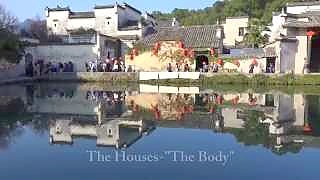
Step back in time in the ancient village of HongCun, 宏村. HongCun is located near the south west slope of Mount HuangShan. The architecture and carvings of the approximately 150 residences dating back from the Ming and Qing dynasties are said to be among the best in China. One of the largest residences open to visitors, ChenZhi Hall, also contains a small museum. Together with XiDi, the village is a UNESCO World Heritage Site. Some scenes from the movie 'Crouching Tiger, Hidden Dragon' were filmed on location in HongCun.
A glimpse of FengHuang 凤凰, HuNan province ...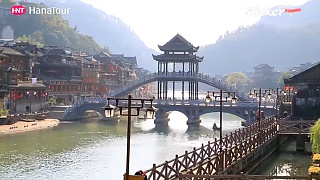
1 minute in Phoenix ancient water town ...
Scenes of ancient China - HongCun 宏村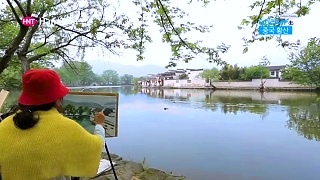
Filmed in July 2013. With Sticker Travel. First film shows the village of HongCun in AnHui province. Scenes from the film 'Crouching Tiger, Hidden Dragon' were filmed in HongCun, which is close to the south slope of Mount HuangShan and a UNESCO World Heritage site. The second film shows some places from WuYuan County, JiangXi province, including LiKeng village. Many of the well-preserved structures here date back to the Tang Dynasty, around 700 AD.
Incense and candles, at BaDaChu 八大处, BeiJing
BaDaChu, 'Eight Great Sights', is a park comprising a number of Buddhist temples and nunneries, some still active, on the slopes of the Western Hills on the edge of Beijing city. Though not as high as XiangShan, and not reaching the mountain top, it is still an energetic climb to the top site. The forested hillside valleys, with many ancient trees, adds much to the enjoyment here; a nice place for a gentle hike in the countryside.